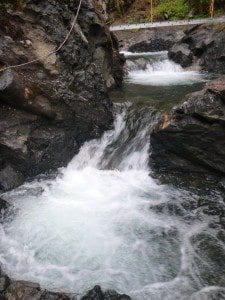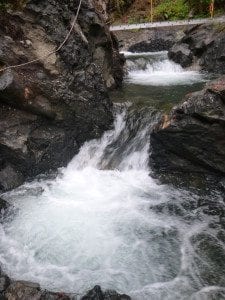Little Falls Fish Passage Improvement
Summary

 Tacoma Power’s improvements at Little Falls on the North Fork Skokomish River in Mason County, Washington, will help secure salmon and steelhead populations for years to come. The project provided many challenges for the team, which used innovation and intellect to overcome them. The project also helped the utility maintain its important relationship with the Skokomish Indian Tribe.
Tacoma Power’s improvements at Little Falls on the North Fork Skokomish River in Mason County, Washington, will help secure salmon and steelhead populations for years to come. The project provided many challenges for the team, which used innovation and intellect to overcome them. The project also helped the utility maintain its important relationship with the Skokomish Indian Tribe.
The flow of the river at Little Falls is divided into two channels, both of which were previously identified as barriers to fish. To help ease fish passage and keep the natural beauty of this culturally significant location, Tacoma Power collaborated with the Skokomish Indian Tribe and permitting agencies to carve a fish ladder into existing bedrock. Weirs were created to maintain water elevations along with resting pools and connecting chutes to allow fish to pass the 12-foot-high falls in a series of bursts.
With the project complete, adult fish can now migrate upstream to the base of Cushman No. 2 Dam to the fish collection and transportation facility.
Background
Little Falls has been recognized as a Traditional Cultural Property to the Skokomish Tribe due to its significance as both a fishing and hunting base. In the late 1920s, Tacoma Power constructed two Cushman dams. The dams restricted the flow in the Skokomish River, which created more obstacles for fish and constricted access for the Skokomish people, affecting their traditional way of life.
After a 36-year-long struggle to relicense the Cushman Hydroelectric Project, Tacoma Power reached a settlement in 2010 with the Skokomish Tribe and natural resource agencies. Among other requirements, the utility agreed to reintroduce and restore fish populations in the North Fork Skokomish River. This includes constructing two hatcheries, a collection and transportation system at the No. 2 Dam, and a floating juvenile fish collector in Lake Cushman. During this process, it was discovered that migrating salmon and steelhead would gather below Little Falls, and with current flow conditions, they were unable to successfully ascend and continue to the adult collector.
Challenge
Complications were attributed to accessibility, geomorphology of the bedrock, and the unknowns of a fish passage project constructed from natural materials. In planning, it became immediately apparent that hand excavation would be the appropriate method of construction. The only entrance to the site was a steep, meandering trail, approximately 700 feet long. The delivery of all tools, equipment and supplies and export of spoils required use of a helicopter.
Innovation
Other than Little Falls, Tacoma Power is unaware of a fish passage structure created entirely out of existing bedrock.
The goal of preserving a Traditional Cultural Property while still providing passage led to creative construction methods. Blasting was used to fracture the rock into reasonable sizes for hand removal during the first half of construction. The inconsistencies in blasting and the deterioration of the rock caused a re-evaluation of appropriate techniques. All parties agreed to complete the remainder of the side channel and the entire main channel using rock drills and chipping guns to remove rock more delicately. Although the timeline was hindered by this decision, it allowed the parties to make the changes needed without damaging the remaining rock.
Results
Tacoma Power was successful in creating a fish passage route while preserving the cultural integrity of the site for the Skokomish Tribe. Even with the setbacks, Tacoma Power adapted to the changes and finished in less than four months. Both channels are open and have successfully passed migrating fish. Biologists are collecting information about the fish passage effectiveness and hydraulics of the falls.
With the improvements, migrating salmon and steelhead can return to the Skokomish River and the population will continue to recover. The Skokomish people will once again be able to return to Little Falls and fish the river as their ancestors did.
Stakeholder Quotes
“The City of Tacoma has become an outstanding partner in the Skokomish Watershed community. After years of debate over the appropriate operations of the Cushman Hydroelectric Project, the Skokomish Indian Tribe and Tacoma Public Utilities, as well as State and Federal agencies, have an agreed-upon plan to guide management of the project, including natural and cultural resource protection, management and restoration activities. Tacoma brought to the attention of the Cushman Fish and Habitat Committee (a formal body of stakeholder representatives) that the North Fork Skokomish River “Little Falls” appeared to be a barrier to fish passage. Tacoma worked with the committee to develop a plan to assess the potential barrier and to eventually develop fish passage improvements. The Skokomish Tribe is appreciative that Tacoma has been diligent in seeking the consultation and concurrence of the Tribe through every step of the process as this site is of great cultural significance.”
– Joseph Pavel, Skokomish Tribe, Natural Resources Director


